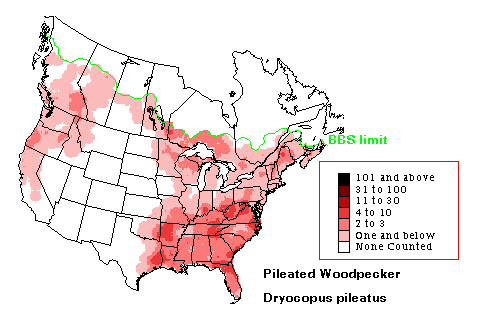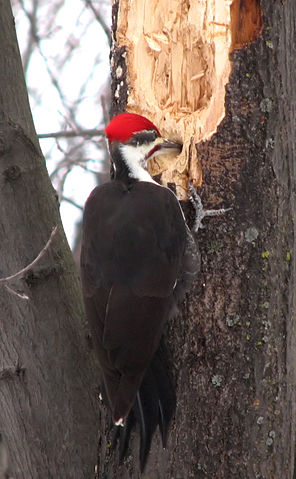The pileated woodpecker (dryocopus pileatus) is one of the most impressive birds in the forest. Crows may be slightly larger, and eagles may look more imposing, but nothing thrills me more than the cry of a pileated woodpecker. To me, they symbolize wild nature more than just about anything else in our woods.
Pileated woodpeckers are hard to see in the forest, but it’s not so much because they’re shy as the fact that they seem entirely uninterested in anything human. They mind their own business, and that rarely has anything to do with people.
According to various sites, they feed largely on carpenter ants, which they usually find in standing or fallen dead trees. That means they need a mature forest that isn’t cut or managed to eliminate dead trees. That tends keep them away from large population centers, since most people don’t want dead trees nearby. Despite this limitation, their range is large. Here’s the US Geological Survey map showing their range.

US Geological Survey figure
According to the USGS website, the pileated woodpecker averages about 15 inches long. It has a prominent red crest and a white throat. It’s almost entirely black, with white on the under side of its wings. But if you’re looking for a pileated woodpecker, I don’t think you will have any problems identifying it. Here’s what the USGS says: “No other living woodpecker could be confused with the Pileated.”
The best view I ever had of a pileated woodpecker was many years ago at my parents’ house. My father had cut a small pine and laid the trunk along the edge of a terrace in the back yard. After it had dried and started to decay, a pileated woodpecker lit on it and started pecking at the bark. When a pileated woodpecker pecks, it hits like a hammer. This bird means business when it feeds.
They are not rare in the woods around the mountain. I hear their call quite often, but although I have looked for an opportunity to photograph one, I haven’t been able to do it. I see them at a distance, too far to photograph, or maybe flying over the road, there and gone before I can even think of getting my camera or phone out.
Since I don’t have one of my own photographs, here’s one from online:

“Pileated Woodpecker male” by D. Gordon E. Robertson
Wednesday I was able to get a poor quality recording of the “wuk” call, along with dark and shaky video of some trees where the bird seemed to be perched. I was with the dogs, and I kept walking while videoing, hoping the bird would fly. I was holding the phone vertically because I wasn’t sure where the bird was and I wanted to catch it if it flew. That’s why there are black bars on either side of the image.
I normalized the volume of the clip, which brings out the call, but unfortunately, it also brings out the jingle of the tags. Sorry about that.
Cornell University has a website with good examples of pileated woodpecker calls. If you have never heard a pileated woodpecker, go listen there and imagine yourself deep in the woods.